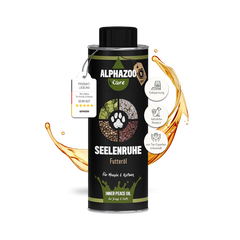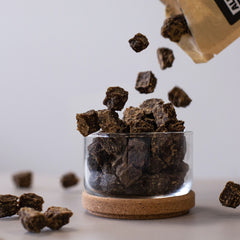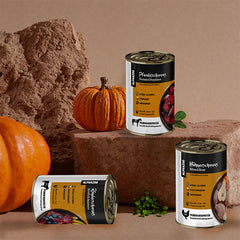Nuts for dogs: What is allowed and what should you avoid?
Nuts are rich in nutrients and a popular snack for humans. But what about our four-legged friends? Can dogs eat nuts? The answer is: It depends! Some nuts can be a healthy addition to your dog's diet, while others are toxic and can cause serious health problems. In this blog, you'll learn which nuts are suitable for dogs, what the risks are, and how to feed them safely.
Can dogs eat nuts? The short answer
Yes, dogs can eat some nuts, but not all. While almonds and peanuts may be safe in small amounts, other nuts, such as macadamia nuts, are toxic and should be avoided at all costs.
What makes nuts problematic for dogs?
- High fat content: Can lead to obesity or pancreatitis.
- Toxins: Some nuts contain substances that are toxic to dogs.
- Choking Hazard: Whole nuts can be swallowed or get stuck in the throat.
The benefits of nuts for dogs
When fed in moderation, some nuts can provide your dog with health benefits. Here are the most important ones:
1. Rich in healthy fats
- Healthy fatty acids such as Omega-3 support skin and coat health.
2. High-quality protein source
- Nuts contain plant protein, which strengthens muscles and tissue.
3. Vitamins and minerals
- Vitamins such as vitamin E promote the immune system.
- Magnesium and potassium support heart health.
4. Antioxidants
- Antioxidants in nuts can prevent cell damage.
Which nuts can dogs eat?
Not all nuts are suitable for dogs. Here's an overview of the nuts that are safe:
1. Peanuts
- Sure, as long as they are unsalted and without the shell.
- Rich in protein and healthy fats.
- Perfect as an occasional reward.
2. Cashew nuts
- Unsalted and raw or lightly roasted, they are safe.
- Contains magnesium and antioxidants.
3. Walnuts (only in moderation)
- Contain omega-3 fatty acids, but can cause digestive problems in large quantities.
4. Hazelnuts
- Safe in small amounts, but be careful of choking hazard.
Which nuts should dogs not eat?
Some nuts are dangerous for dogs and can even be poisonous. Here are the most important ones to avoid:
1. Macadamia nuts
- Extremely toxic to dogs, even in small amounts.
- Symptoms: tremors, paralysis, vomiting and fever.
2. Bitter almonds
- Contains amygdalin, which is converted into hydrogen cyanide and is toxic.
3. Pecans
- Can cause vomiting, diarrhea and neurological problems.
4. Brazil nuts
- Very high in fat, which increases the risk of pancreatitis.
5. Walnuts (moldy)
- Mold on walnuts can contain the neurotoxin mycotoxin.
Risks of feeding nuts
Even nuts that are safe for dogs pose some risks:
1. High fat content
- Too many nuts can cause obesity or pancreatitis.
2. Danger of suffocation
- Whole nuts or hard shells can get stuck in the throat.
3. Allergies
- Some dogs may be allergic to nuts. Watch for symptoms such as itching or breathing problems.
4. Mold
- Mold on nuts can be toxic and cause neurological damage.
How do you properly feed nuts to your dog?
Proper preparation and feeding of nuts are crucial to avoid risks:
1. Chop nuts
- Cut or chop the nuts into small pieces to avoid the risk of choking.
2. Only unsalted nuts
- Salt and spices are harmful to dogs and can cause kidney problems.
3. In small quantities
- A maximum of a few nuts per week, depending on the size of your dog.
4. Remove shells
- Shells are difficult to digest and can block the digestive tract.
5. Observe your dog
- Give your dog a small amount and observe him for possible intolerances.
Creative ways to offer nuts to dogs
Nuts can be prepared in different ways to offer your dog variety:
1. Nut butter
- Unsalted peanut or cashew butter is great as a reward or for filling a Kong.
2. Homemade dog biscuits
- Mix ground nuts with oatmeal and bananas, form small cookies and bake them.
3. Nut topping
- Crushed nuts can be sprinkled over the main food as a topping.
4. Nut smoothie
- Puree a small amount of nuts with unsweetened natural yogurt.
Frequently asked questions about nuts for dogs
“Can dogs eat peanut butter?”
Yes, as long as it's unsalted and has no added sugar. Make sure it doesn't contain xylitol, as this substance is toxic to dogs.
“Are all nuts dangerous for dogs?”
No, some nuts, such as peanuts or cashews, are safe in small amounts. However, others, such as macadamia nuts, are toxic.
“How many nuts can my dog eat?”
Small dogs: 1-2 nuts per week, large dogs: up to 5 nuts per week.
“Can puppies eat nuts?”
Puppies should not be given nuts because their digestive system is more sensitive.
Conclusion: Nuts for dogs – healthy, but with caution
Nuts can be a healthy addition to your dog's diet if you choose the right varieties and feed them in moderation. Key points at a glance:
- Safe: Peanuts, cashews and hazelnuts in small quantities.
- Dangerous: Macadamia nuts, bitter almonds and moldy nuts.
- Preparation: Chopped, unsalted and without shells.
With these tips, you can safely and confidently offer nuts to your dog. They're not only delicious but also packed with healthy nutrients—as long as you choose the right varieties!

















